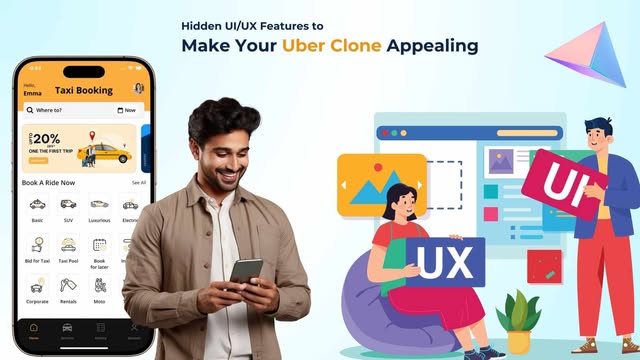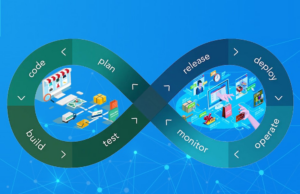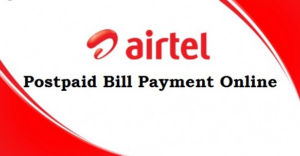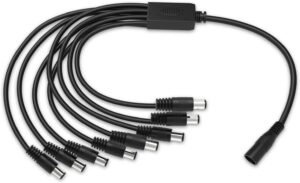
The future of the transportation business relies on ride-hailing apps like Uber Clone, which are highly responsive to UI/UX design. UI manages the design and layout, while UX refers to the app’s functionality and data management. Both are interconnected and need to be perfectly aligned to ensure the overall success of your app. UI/UX determines the level of user experience.
Introduction
If you open the original Uber app, you’ll notice that the size and placement of icons and buttons are well-placed. This makes them easy for the user to access. Place options can be used with professional typography, such as different font sizes, weights, and styles, to differentiate essential information (such as current location and destination) from secondary details (such as driver ratings or ride options). For this reason, many successful Uber clones are developed by teams that foster close collaboration between UI and UX specialists, ensuring a unified approach to app design. The idea of creating an Uber Clone is a good one, but success lies in a perfectly constructed UI/UX.
What are the hidden UI/UX features that will make your Uber Clone appealing?
Pay in the Blink of an Eye
There are multiple payment options to cater to diverse customer preferences. People always choose the easiest and fastest way to pay. Regardless of the payment option you choose, such as credit cards, debit cards, or mobile wallets, this will lead to a hassle-free payment process, build trust, and boost conversions. Additionally, it enhances trust and encourages repeat orders.
Recommendations from Previous Rides
You can provide tailored recommendations to increase customer retention by leveraging data analytics. This includes preferred drivers, suggested destinations, and personalized discounts. This not only creates a sense of connection but also increases customer loyalty.
Live Tracking of Driver Activity
The need for real-time tracking in the Uber Clone app cannot be overemphasized. Designing a fast-paced, interactive user interface that provides useful metrics such as the expected time of arrival (ETA) with live updates on driver movements enhances the overall user experience. Knowing the progress of a trip from the moment it is placed eliminates anxiety and uncertainty. This level of transparency, from trip confirmation to arrival at the destination, reduces potential concerns and ensures a seamless user experience.
Notification to Keep Users Updated
Push notifications effectively keep customers informed about their trip status without having to check your Uber Clone app. Furthermore, timely promotions sent through notifications can also attract new trips. These notifications remind users to continue taking taxis despite multiple distractions.
Customer Support and Feedback
A robust feedback system is the foundation of customer satisfaction and business growth. Among tax booking apps, these support options and a seamless feedback mechanism value customer inquiries for continuous improvement across all business segments. This can be achieved through the app’s live chat feature, which responds within minutes to guide the user to a satisfactory outcome.
Screen Loading Time Has Become Faster
People use taxi apps to expect instant gratification. Therefore, slow loading times or lagging app performance can lead to app abandonment. Competition is high, and errors like these can slow down business progress. Loading speed plays a crucial role in determining the overall user experience of Uber Clone. Users have come to expect instant access to information, and the time it takes to load a taxi app has become an important factor in determining its success.
Hidden Elements to Enhance the User Login Experience in an Uber Clone App
When users come to your app, a visually appealing yet simple signup or registration screen signals trust. If your customers find the design poor and painful, they won’t risk requesting a ride. Instead, they’ll uninstall the app because of a poorly designed signup screen. Therefore, your best designers should spend enough time creating a unique and simple box that represents your brand and vision.
Use Password Less Logins
Biometric authentication, such as fingerprint scanning, facial recognition, or iris scanning, is emerging as a viable password less solution. These leverage device-level sensors and hardware encryption for verification.
Uber clones can offer sensor-based logins as an option for their highly mobile and security-conscious user base. Any technology that can securely eliminate the need to remember passwords is a leap forward for the login user experience.
Auto-Save Progress
When users are required to fill out data across multiple stages, there is a risk of losing the information they have entered if they accidentally exit the app or encounter connectivity issues. Losing input progress is extremely annoying.
The easiest solution is to implement auto-save at very short intervals. For example, text entered into forms can be saved every 5 seconds. This way, even if users have to restart, the chances of their input information being erased are reduced. Use visual cues to indicate that progress is being backed up.
Enable Easy Password Recovery
It’s very common for users to forget their passwords and need to reset them before they can log in again. Enabling easy and quick account recovery in such situations is vital for Uber clones handling time-sensitive bookings.
The standard approach is to associate passwords with verified emails. The reset option triggers a notification in the user’s email with a unique link to create a new password. Just a few clicks to receive instructions and reset is extremely convenient.
Remember Devices
This feature gives users the option to stay logged in on frequently used devices, such as phones and tablets used by daily drivers. This prevents authentication every time they open or return to your app on these registered devices.
The option to stay logged in certainly enhances convenience and helps build the habit of interacting with your Uber clone.
Design Consistent, Branded Looks
While building functional forms in all required areas is essential, attention to visual processing is also important when forming first impressions. Maintaining visual consistency across sign-up touchpoints helps establish the app’s legitimacy for new visitors through a familiar design.
From colours to fonts, input controls, and button layouts—using the same interface elements quickly reinforces brand associations in the minds of new users. Leveraging existing mental models around established brands sets clearer expectations even when users first explore your Uber clone.
Provide Contextual Help
No matter how streamlined your sign-up flows are, users may still need assistance due to their unfamiliarity with mobile interfaces. Timely, contextual support helps prevent user interruptions during registration or login due to a lack of understanding or technical difficulties. Providing easily accessible support significantly improves completion and approval rates.
Conclusion
The user interface and user experience can help meet the rising expectations of consumers experiencing the smartphone boom. Remember, a robust and seamless registration screen leaves a good first impression. From smart verification to switching to an automatic keyboard font system, you can spend time optimizing every little detail and move forward with satisfaction.
Get help from a seasoned app development company to create an Uber clone that engages users from day one. You can save time and money, avoiding costly revisions and updates with a custom clone script. In just 2-3 weeks, your ride-hailing company can be on the market.






